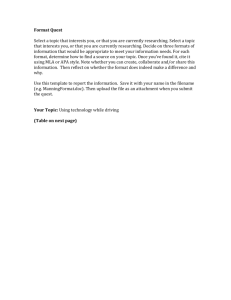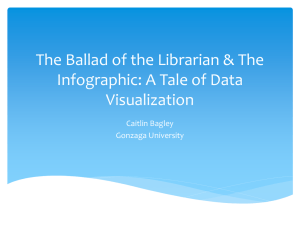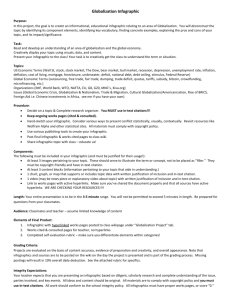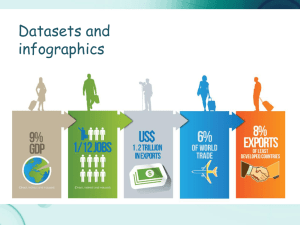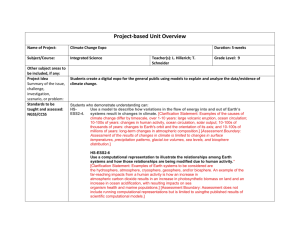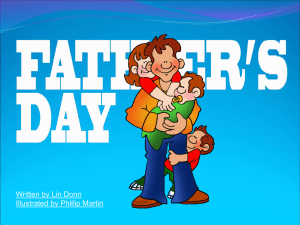Global Climate Change: Trend, Evidence, Impact
advertisement
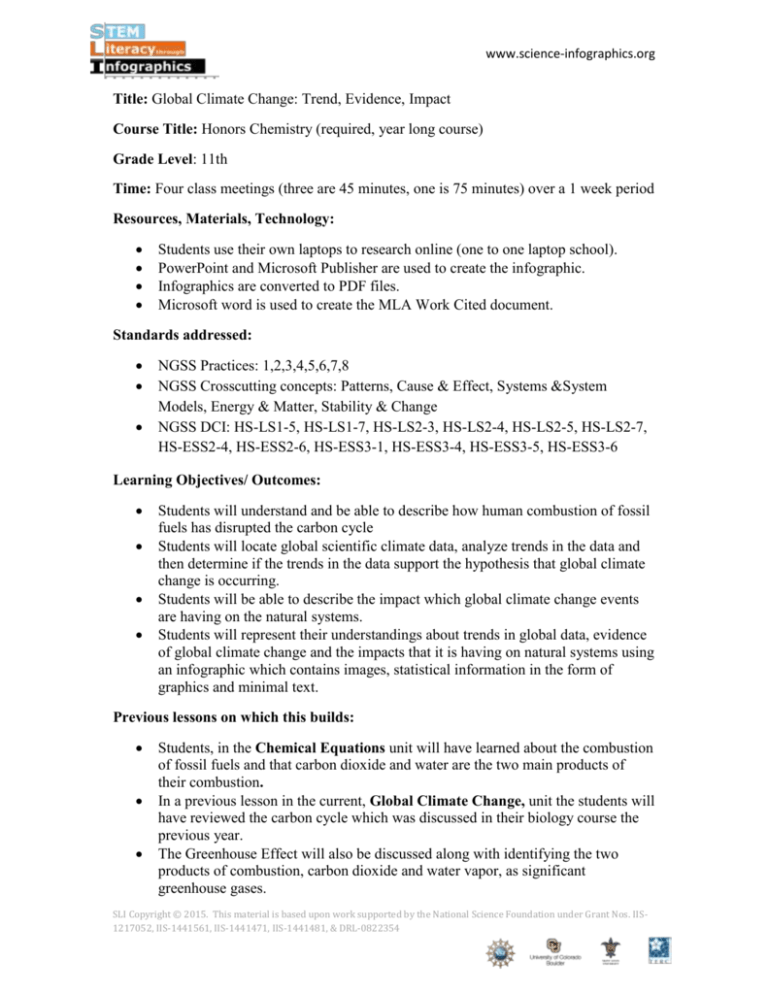
www.science-infographics.org Title: Global Climate Change: Trend, Evidence, Impact Course Title: Honors Chemistry (required, year long course) Grade Level: 11th Time: Four class meetings (three are 45 minutes, one is 75 minutes) over a 1 week period Resources, Materials, Technology: Students use their own laptops to research online (one to one laptop school). PowerPoint and Microsoft Publisher are used to create the infographic. Infographics are converted to PDF files. Microsoft word is used to create the MLA Work Cited document. Standards addressed: NGSS Practices: 1,2,3,4,5,6,7,8 NGSS Crosscutting concepts: Patterns, Cause & Effect, Systems &System Models, Energy & Matter, Stability & Change NGSS DCI: HS-LS1-5, HS-LS1-7, HS-LS2-3, HS-LS2-4, HS-LS2-5, HS-LS2-7, HS-ESS2-4, HS-ESS2-6, HS-ESS3-1, HS-ESS3-4, HS-ESS3-5, HS-ESS3-6 Learning Objectives/ Outcomes: Students will understand and be able to describe how human combustion of fossil fuels has disrupted the carbon cycle Students will locate global scientific climate data, analyze trends in the data and then determine if the trends in the data support the hypothesis that global climate change is occurring. Students will be able to describe the impact which global climate change events are having on the natural systems. Students will represent their understandings about trends in global data, evidence of global climate change and the impacts that it is having on natural systems using an infographic which contains images, statistical information in the form of graphics and minimal text. Previous lessons on which this builds: Students, in the Chemical Equations unit will have learned about the combustion of fossil fuels and that carbon dioxide and water are the two main products of their combustion. In a previous lesson in the current, Global Climate Change, unit the students will have reviewed the carbon cycle which was discussed in their biology course the previous year. The Greenhouse Effect will also be discussed along with identifying the two products of combustion, carbon dioxide and water vapor, as significant greenhouse gases. SLI Copyright © 2015. This material is based upon work supported by the National Science Foundation under Grant Nos. IIS1217052, IIS-1441561, IIS-1441471, IIS-1441481, & DRL-0822354 www.science-infographics.org Students have been trained in a required Digital Literacy course in how to carry out online searches, how to use Microsoft Word, PowerPoint and Publisher. Google docs and Google slide have also been introduced to the students and many choose to use this for sharing during group or team projects. Blackboard is used within the school to transmit files between teacher and student. Within this course previously the students have created line graphs and bar graphs. Lesson Structure and Procedures: Before the Lesson At the end of the prior day’s lesson on the Greenhouse effect students participated in a class brainstorming session on the evidences cited by scientists to support the hypothesis that the Earth’s climate is changing of which they themselves are aware. Once the prior knowledge of the students on this subject is exhausted the student are allowed time to use their computers to investigate further evidences to add to the class list. Using search terms such as evidence of global warming, global climate change, climate change, carbon dioxide, and greenhouse gases, a variety of evidence topics emerges. The goal is to have as many topics or more than the student groups in the class. This brainstormed list forms the backbone for the topic selection activity which takes place on Day 1. Day 1: 45 minutes in length The focus of this period is the familiarization of the students with the project expectations: o Teams of 2 students will each research one of the evidences of global climate change listed in the table below. o Teams will gather data to determine the trend in the evidence. o Teams will create a graph of the data to illustrate the trend in the evidence. o Teams will gather information on the impact which that trend is having on earth’s systems which include the biosphere, the atmosphere, the lithosphere and the hydrosphere. o Teams will create an infographic which communicates the trend, evidence graph and impact for their topic. Students are introduced to the infographic assignment. They are given the list of brainstormed topic ideas along with the student direction sheet (attached). Students select a partner with whom they want to work on the project. Each team is given a number selected by random which determines their position in the choosing of topics. Once each team has a topic, the format of an infographic is described by the teacher. SLI Copyright © 2015. This material is based upon work supported by the National Science Foundation under Grant Nos. IIS1217052, IIS-1441561, IIS-1441471, IIS-1441481, & DRL-0822354 www.science-infographics.org Examples of infographics are presented. At this point only a vague sense of the format, designing of an infographic is held by the students. The details of the content needed for their infographic is discussed using the student direction sheet (attached) as a guide. Students are then given the remainder of the period to begin researching their topic. During this time the teacher circulates to each team to verify that they understand the task at hand and are making progress on collecting information. At the end of the period they are encouraged to continue their research for homework and to bring the results of their searches to class the next day. Day 2: 45 minutes in length The focus for this class period is forming the connection between the students and the information that they are gathering. The class begins with a check point discussion where students are asked to share what they have learned so far about their topic. Each team is probed to describe the trend which they are finding in the evidences that they are researching. Students are then shown how to carry out a search using Google to locate images which are copyright free and therefore able to be used on their infographic. Students continue working on their collecting of content and now images with the teacher available to discuss any area of concern. During this period the teacher circulates to each team to verify that they not only are collecting information but beginning to synthesize it into new understandings of the evidences for global climate change and how global climate change is impacting natural systems. At the end of the period they are encouraged to continue their research for homework and to bring the results of their searches to class the next day. They should arrive for class with all of the information and images that they feel they will need in order to create their infographic. Day 3: 75 minutes in length The focus for this class period is the creation of the infographic itself. Students are shown examples of previously created infographics on other topics using the PowerPoint and Publisher format. The logistics of sharing pictures and information with their partner are discussed and worked through. Students are given the entire period to create their infographic; compiling their information, creating graphs of their statistics and then working on the artistic design and presentation format. Students are directed to continue working on their collecting of content and now images with the teacher available to discuss any area of concern. During this period the teacher circulates to each team to help with formatting and design issues that arise. At the end of the period students are reminded that the completed infographic, along with the MLA formatted work cited are due before 8 AM on the next class SLI Copyright © 2015. This material is based upon work supported by the National Science Foundation under Grant Nos. IIS1217052, IIS-1441561, IIS-1441471, IIS-1441481, & DRL-0822354 www.science-infographics.org period. This will allow the teacher time to print out the infographics for the Gallery Walk which will take place during the next class period. Students are also reminded of the teacher’s availability to help with any issue which arises during the intervening days. (This project was set up to have a weekend of team work time available between the infographic work day and the Gallery Walk). Day 4: 45 Minutes in length The focus for this class period is the presentation of the infographic by the student during a Gallery Walk which is in a Speed Dating format. The infographics are displayed on the walls in the hallway outside of the classroom by the teacher before the class takes place. The students are divided into two groups with one member of each team on each group. The first group will present their infographics, they are asked to go out in the hallway and stand next to their infographic. The second group will serve as audience members. They will each pair up with one of the presenters. Every twothree minutes the audience will circulate, in a pattern, to the next presenter. During the presentation time the teacher circulates to listen to the presentations and to gauge when the next shift should occur. After each presenter has been heard by the majority of the audience members, the audience switches to become the presenters and the presenters become the audience. The process of presenting then shifting begins again and continues until the majority of the presenters have been heard by each member of the audience. At the end of the period, or at the beginning of the next one if time has run out, the class has a recap of what was learned from this experience. Finally, the students are asked to vote for their favorite presentation. They are asked to explain why they made the choice that they did. Student directions/handouts: Trends, Evidence and Impacts of Global Climate Change Objective: SLI Copyright © 2015. This material is based upon work supported by the National Science Foundation under Grant Nos. IIS1217052, IIS-1441561, IIS-1441471, IIS-1441481, & DRL-0822354 www.science-infographics.org You will understand and be able to describe how human combustion of fossil fuels has disrupted the carbon cycle You will locate global scientific climate data, analyze trends in the data and then determine if the trends in the data support the hypothesis that global climate change is occurring. You will be able to describe the impact which global climate change events are having on the natural systems. You will represent your understandings about trends in global data, evidence of global climate change and the impacts that it is having on natural systems using an infographic which contains images, statistical information in the form of graphics and minimal text. Student Directions: 1. Working with a partner, you will choose one of the evidences of global climate change which resulted from our class brainstorming session to research. These are listed below. 2. You and your partner will research your chosen topic and then prepare a one page infographic on that topic to present to the class during a gallery walk. 3. Your research gathered and presented on the infographic should contain the following content about the evidence chosen: a. The trend in the evidence over time is determined and clearly and correctly described. b. The change over time for that evidence is correctly illustrated graphically. c. The impact which that event is having on Earth’s systems is fully represented graphically, pictorially or with succinct descriptions. Earth systems include the biosphere, the atmosphere, the lithosphere and hydrosphere. 4. Your research findings are creatively composed into a one page infographic which is 8.5 x 11 inches in size. Microsoft Publisher is great for this. Make your infographic interesting and eye catching. The final infographic will be saved as a PDF and then uploaded through Blackboard. 5. While any program can be used to create the infographic, the final submitted project must be PDF file formatted to 8.5 x 11 inches with all students’ last names provided in the file name. 6. The sources of the information and pictures are cited on a separate word document which is also uploaded through Blackboard. 7. The quality of the sources used for your information, the quality of the information presented and the quality of the infographic itself are all features which will impact your grade on this project. Specifics are detailed on the Specification Sheet. 8. It is your team’s responsibility to insure that all members have access to the final product and are prepared for their presentation during the gallery walk. SLI Copyright © 2015. This material is based upon work supported by the National Science Foundation under Grant Nos. IIS1217052, IIS-1441561, IIS-1441471, IIS-1441481, & DRL-0822354 www.science-infographics.org Evidences to Examine: A Ice Cores in Antarctica and Greenland B Sea Level measurements C Global Temperatures D Ocean Temperatures E Lake Temperatures F Size of ice sheets in Antarctica and Greenland G Size of arctic sea ice H Size, length of glaciers I Number of extreme weather events J Ocean acidification K Amount of snow cover L Changes in seasonal migration patterns M Changes in animal or plant populations Trends, Evidence and Impacts Infographic Scoring Guide Excellent meets all described features completely and shows originality and creativity using additional features that add to the presentation. The information is presented at the honors, high school level of rigor. Present meets all the described features but is lacking in originality, creativity, or rigor. Needs Improvement means that the coverage is lacking key facets of the material or formatting features. Missing means that the presence of that particular feature is not found and all points will be deducted. Content Features 20 Points possible The science content represented in the infographic has significance and is appropriate to the topic. Extraneous, nonessential or nonscientific information which detracts is not included. The trend in the evidence is clearly and correctly stated; what it shows about changes over time. The changes over time are correctly illustrated using a graph. Excellent = 20 Present = 16-19 Needs Improvement = 12-16 Missing = < 12 SLI Copyright © 2015. This material is based upon work supported by the National Science Foundation under Grant Nos. IIS1217052, IIS-1441561, IIS-1441471, IIS-1441481, & DRL-0822354 www.science-infographics.org The impact which that trend is having on earth’s systems which include the biosphere, the atmosphere, the lithosphere and the hydrosphere are fully represented. Quality, Layout and Formatting Features 20 points possible The infographic has a descriptive title and an opening sequence which serves as a hook for the audience: the intent, purpose is made clear for the audience. The information flows with the main, most important ideas given prominence. The content is presented in a unique, dynamic and creative manner through the use of graphics such as pictures, tables, graphs, word art. The artistic quality of graphics does not detract from their presentation. Images are crisp and appropriate to the topic. Text is clear and legible. Color choices, font size and format are appropriate to the topic and overall presentation. Images are copyright free or student created. Student or the artist is given credit beneath the image. Care and effort is taken with hand drawn images. The mathematical relationship between quantities or properties is shown graphically not in tables. Graphs and tables are properly formatted. Understandable and accurate labels and units are included on graphs and tables. All graphs or tables are created by the students, and the information used to create them is credited beneath the graphic. Citing Sources Excellent = 20 Present = 16-19 Needs Improvement = 12-16 Multiple, credible sources of data and information are used. The name of each source of information is cited below the element in which it is used in font size 6 or 8. The full MLA formatted work cited is provided as a separate word document with the URL provided for each electronic source. This document includes a heading and is final, not draft quality Gallery Walk Presentation Excellent = 5 Present = 4 Needs Improvement = 3 Each member of the team is available and presents during the gallery walk. Presentations are prepared in advance and are the same for each presenter. Presentations are crisp, clean and last no more than 2 minutes. Team members are respectful of audience members and of other student’s presentations. Total Points Possible Excellent = 5 Present = 4 Needs Improvement = 3 Missing = < 12 5 points Missing = < 2 5 points Missing = < 2 50 points (100 points is the normal weight of a test in this course) Follow Up/Extensions: SLI Copyright © 2015. This material is based upon work supported by the National Science Foundation under Grant Nos. IIS1217052, IIS-1441561, IIS-1441471, IIS-1441481, & DRL-0822354 www.science-infographics.org Student projects can be displayed in the school and viewed by the school community. Student projects could be written about in the school paper with examples given to illustrate and to spark a debate about Global Climate Change. Students can be asked to write a reflection on what they found most memorable about their own topic of research and why. Students can be asked to write a reflection on which of the topics presented by their peers was most memorable and why. Student projects on Global Climate Change can be discussed within their Social Studies courses with citizen involvement as the theme. Questions such as, “Should the US be changing our energy production strategies order to decrease our reliance on fossil fuel?” could be posed to spark these discussions in the Social Studies course or as a follow up discussion in the science classroom. Examples of student work: SLI Copyright © 2015. This material is based upon work supported by the National Science Foundation under Grant Nos. IIS1217052, IIS-1441561, IIS-1441471, IIS-1441481, & DRL-0822354 www.science-infographics.org SLI Copyright © 2015. This material is based upon work supported by the National Science Foundation under Grant Nos. IIS1217052, IIS-1441561, IIS-1441471, IIS-1441481, & DRL-0822354 www.science-infographics.org SLI Copyright © 2015. This material is based upon work supported by the National Science Foundation under Grant Nos. IIS1217052, IIS-1441561, IIS-1441471, IIS-1441481, & DRL-0822354 www.science-infographics.org SLI Copyright © 2015. This material is based upon work supported by the National Science Foundation under Grant Nos. IIS1217052, IIS-1441561, IIS-1441471, IIS-1441481, & DRL-0822354

